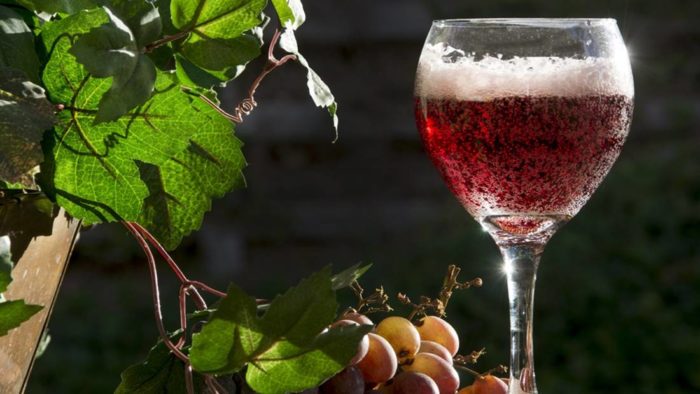Today’s post is written by Vine.ly Magazine Founder Birdie deQuay. Whether it’s a relaxing girlfriends night in or a dinner with the husband, we often celebrate events with by raising a toast with some bubbly. While champagne is usually the beverage of choice, Birdie shows us that so many other options exist. I know I’ll be trying something new this month!
The Go-To Bubbly
In addition to champagne, a multitude of sparkling wines are waiting to be discovered. Why aren’t they as popular as champagne? What is it that sets them apart from everyone’s favorite go-to bubbly and why shouldn’t we look to others when celebrating?
When it comes to sparkling wines, one name outshines them all. Champagne, always with a capital C, hails its name from the region where it’s derived in northeastern France. The name is so important that if it does not come from Champagne, you can’t call it Champagne.

The Background on Champagne
Originally, the Champagne region was known for its still and red wines. Then Dom Pérignon arrived. Pérignon, a monk, has often been dubbed the first maker of sparkling wines. However, this is false; sparkling wines had been around for at least a hundred years before Pérignon was born. Nevertheless, he can be credited with substantially improving its quality. Thank you, Dom!
In fact, the tradition carries on today. Dom Pérignon is the most recognized brand of champagne, produced by makers Moët & Chandon. However, it’s not the only sparkling wine to come from Champagne. Here you’ll also find familiar names including Taittinger, Pommery and Veuve Clicquot.
One important question: are these the best sparkling wines to drink? Be prepared to drop a buck or a hundred on these brands, but can you really tell the difference? A wine expert will certainly tell you there is a noticeable distinction between a $10 bottle from Target and $100 bottle from a wine shop, but could you or any of your friends discern the difference? If you poured a $10 bottle into an empty Pérignon bottle, could you fool everyone around you? Likely. And isn’t it fun to ring in the New Year having fun on a budget?
Sparkling White Wine Anyone?
What is sparkling white wine? It’s the fizzy, sometimes-sweet white wine that isn’t isn’t from Champagne. Remember the rule: California sparkling wines exist but there’s no such thing as California Champagne. If it does say California Champagne, your beverage was produced before the rule was established; it’s a long-standing exception meant to confuse us all.
Cava Please
Cava is a Spanish sparkling wine. Existing in both white and rosé, it is truly meant to please. With a sweet, fizzy taste that’s also slightly dry and crisp, it can surely please a range of taste buds. The main difference between Cava and Champagne stems from the types of grapes used in the process. Different grapes yield different tastes and experiences.
Excuse me, Espumante?
Now here is a confusing sparkling wine. Espumante, a ‘green wine’ that hails from Portugal, can be white, rosé, or red–and not green like its name. The green association comes from the green hue of the grape when it’s ripe to sell. While these grapes do have some sparkle to them, it’s not enough to fashion a truly sparkling wine.
What is Espumoso You Ask?
Espumoso is another Spanish sparkling wine, similar to Cava, although not as widely popular or favorable.
Have You Heard About Lambrusco?
The name of the Italian grape variety, it is the chameleon of wine. Either dry or sweet, this sparkling wine is usually red in color, but could also be white or rose, depending on the maker. Available in semi or full sparkling, this versatile gamechanger can hit the mark for all who dare. Gotta catch them all? More like try them all.
Oh Prosecco?
Another favorite, which can oftentimes be found a party, is Prosecco. This party-classic hails from northern Italy. A fun fact about Prosecco: it can be bought as semi-sparkling or fully sparkling. In other words, you can make a variety of people happy with choices. Prosecco is also slightly lower in alcohol content than other sparkling wines, thus you can enjoy more. A fan favorite sure to please even the pickiest of wine drinkers.
Oh That Cap Classique
Cap Classique, how classy does that sound? It’s the generic labeling for sparkling wines produced in South Africa. Although made the same way that champagne is, the name alone does hold class, so you might want to add this to your next party. That way, you can tell Debbie in the office that you do in fact, have class.
Don’t Forget Sekt
Coming from our German cousins, we have Sekt, another variety of sparkling wine. Mirroring the way champagne is produced and sold, the price of Sekt tends to indicate its quality compared to other wines.
A Nightcap On This Mini-Lesson
Is Champagne truly unique enough that it should continue to reign supreme for special occasions involving bubbly? Or during this mini-lesson, did you identify something else that might pique your interest for your next celebratory beverage? Will another sparkling wine now take Champagne’s special place?

Honey, I really enjoyed this one! I’m curious….I’m sure you’ve had Dom Perignon…is it really good? I would love to try it one day, but don’t want to spend that much just to take a sip. lol Thanks!